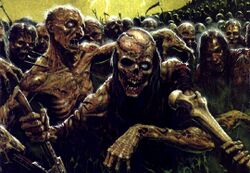Zombie
Zombies are monsters which are mindless and created from humans. Everything else depends on the legend or tradition.
IRL zombies
In certain African and Haitian Voodoo myths, zombies are created by administering a potion that places the drinker into a state of near-death where they obey the commands of whoever made the potion. This is where the term "zombie" (or "zombi") comes from.
In Voodoo practices, zombies are created using "Zombie Powder", a powdery substance created from pufferfish poison that renders the victim into a near-death paralyzed state, effectively making them look "dead" for a long period of time. Although, because their heavily paralyzed state, it's a no brainer you can't turn them into mindless servants, unless the only command you want to give them is "play dead".
Fun Facts: the Servitors are based on this style of zombies(with Cyborg body parts)
Fantasy zombies

Zombies in fantasy are corpses re-animated through dark magic. Usually, they are animated and controlled by necromancers. They tend to be slow, clumsy, and weak, but because they are relatively easy to make in large numbers (especially if there are any graveyards or battlefields close at hand -- in fact, particularly nasty necromancers will do things like annihilate an entire town or army and re-animate everyone). They remain a staple of the undead hordes, just next to skeletons.
Depiction of zombies tend to vary through each setting. Some have enough intelligence to use weapons, magic, and even crude tactics, some are able to fully or mostly retain their higher functions after reanimation, while some are just shambling undead corpses who wants to take a bite out of you.
Magic: the Gathering
The main 2 undead creature types are zombie and skeleton (vampires also have a creature type). As such things like lichs have the zombie creature type (on their cards).
Innistrad
Innistrad zombies come in 2 flavors. The black zombies are the typical reanimated with black magic zombie that is almost ubiquitous throughout fantasy. The blue zombies are more SCIENCE themed (think Frankenstein's monster).
Modern zombies
Zombies in modern settings tend to be the by-products of science rather than necromancy. Some animating agent, usually a chemical or virus (though radiation is not unknown), causes corpses to move around, and for some reason makes them hunger for living flesh. Although this is sometimes explained as the reptilian part of the human brain, which is only centered around finding something to eat, still being prevalent while the other parts responsible for higher reasoning and functions are dead. Thus, without anything really else on their minds but to hunt and eat, all they do for the rest of their undead lives is lumber about and occasionally relentlessly chase someone down to devour, even if they don't have any real reason to do so. This' however, doesn't explain why they don't eat each other...(though Romero Zombies' inability to attacks anything that aren't sapient are explains this)
Optionally, people who are killed or bitten by zombies may themselves rise again as zombies; in such cases, this reanimation can usually be prevented by destroying or removing the head, or incinerating the corpse (decapitation and fire usually work well on putting down zombies post-reanimation as well). George Romero's Night of the Living Dead movie set the tone for the archetypal modern zombie, to the point that zombies of this archetype are sometimes called "Romero zombies", even though nobody actually says the word "zombie" in the movie itself. George Romero did another zombie movie, Dawn of the Dead, where there's an implied return to the idea of zombies from supernatural origins ("When there's no more room in hell, the dead will walk the earth"). Another more recent trait was the need to eat brains, introduced in the horror-comedy movie Return of the Living Dead (in it, the zombies eat brains because they're in pain since they can feel their bodies decompose and eating brains stops that pain; likey from ingesting the endorphins it carries).
More recently, especially in video games, another pattern of zombie has gained popularity: the so-called "fast zombie" or "28 Days Later zombie" (though the creatures in 28 Days Later are not proper zombies at all, as they are still alive, albeit infected with a rabies-like behavior-altering virus). As the name suggests, these creatures are fast and aggressive, and can be terrifying in small numbers, especially if they can infect with a single bite.